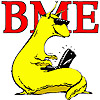
|
| SoE home |

|
| Kevin Karplus's home page |

|
| Biomolecular Engineering Department |
The basic ingredients of mead are honey, water, and yeast. The proportions of the honey and water determine the final strength and sweetness of the drink, also how long it takes to make. The ratio ranges from 1 lb. honey per gallon of water for a very light "soft-drink" to 5 lbs. per gallon for a sweet dessert wine. The less honey, the lighter the mead, and the quicker it can be made. I've successfully made a 1 lb/gallon mead in as little as three weeks, while my strongest mead (5 lb/gallon) was not bottled for six months, and could have stood another few months before bottling. Elizabethan recipes varied considerably in strength, but 3 or 4 pounds of honey per gallon was common.
The mead I make is spiced, so is sometimes referred to as "metheglin."
Elizabethan meads used large numbers of different spices and herbs, but
not always in large quantities. Kenelm Digby, after giving the recipe
obtained from "Master Webbe, who maketh the Kings Meathe," has this to
say:
The Proportion of Herbs and Spices is this; That there be so
much as to drown the luscious sweetness of the Honey; but not so
much as to taste of herbs or spice, when you drink the Meathe.
But that the sweetness of the honey may kill their taste: And so
the Meathe have a pleasant taste, but not of herbs, nor spice,
nor honey. And therefore you put more or less according to the
time you will drink it in. For a great deal will be mellowed
away in a year, that would be ungratefully strong in three
months. And the honey that will make it keep a year or two,
will require a triple proportion of spice and herbs.
[The Closet of the Eminently Learned Sir Kenelm Digby Knight Opened,
1669]
Here is a partial list of flavoring agents (mainly herbs and spices) mentioned for meads by Digby: agrimony, angelica root, avens, baulme leaves, bay leaves, bettony, blew-button, borrage, cinnamon, clove-gilly flowers, cloves, dock, eglantine, elecampane, eringo roots, fennel, fruit juice (cherries, raspes, Morrello cherries), ginger, harts-tongue, hopps, juniper berries, limon-pill, liver-worth, mace, minth, nutmeg, orris root, parsley roots, raisins, red sage, rosemary, saxifrage, scabious, sorrel, strawberry leaves, sweet marjoram, sweet-briar leaves, thyme, violet leaves, wild marjoram, wild sage, wild thyme, and winter savory.
In my own brewing, I use mainly "sweet" spices (cinnamon, ginger, nutmeg). The main herb I use is tea. Tea is an important addition to the mead. It provides tannic acid, to give the drink a bit of bite. It is particularly important for sweet meads, which can otherwise have a rather syrupy taste (like Mogen David wines). Any sort of tea will do--I've used genmai cha (a very light Japanese green tea), lapsang souchong (a smokey Chinese tea), China Rose (a black tea with rose petals), jasmine, oolong, and others. If you want to use Lipton's, that should work as well. I have not seen any period recipes that use tea in mead, but all my batches that omitted tea were not as good. I am more interested in producing good flavor that in strict authenticity, so continue to use tea.
Other ingredients I use include small amounts of orange or lemon juice, fruit, cloves, and other spices. I've used bay leaves, cloves, rosemary, anise, and galingale, in addition to the spices listed above. Be careful not to over-spice the mead! It is probably safer to use less of fewer spices, until you've had some experience.
As examples, here are the quantities for two of my mead batches:
Batch: M4 Type: Quick Mead 3 gallons water 5 lbs honey (Wild Mountain) 1/3 cup jasmine tea 1/2 tsp ground ginger 2 tsp cinnamon 1/2 tsp ground allspice 1/2 tsp ground cloves 1/2 tsp ground nutmeg ale yeast Started: 1 July 1979 Yeast added: 2 July 1979 skimmed: 12 July 1979 racked: 15 July 1979 bottled: 28 July 1979 yield: 3.1 gallons clarity: excellent sweetness: fairly sweet sediment: slight carbonation: variable (some popped corks) color: light gold An excellent batch ------------------------------------------------------------ Batch: M7 Type: Sack Mead 3 gallons Water 16 lbs honey 1/4 cup keemun tea 1/4 cup oolong tea 2 tsp cinnamon 1/2 tsp whole aniseseed 18 cardamum seed clusters crushed (about 1 tsp) 20 whole allspice slightly crushed (about 3/4 tsp) about 1 inch galingale root crushed (about 2 1/4 tsp) (Fining agent: 1 pkg unflavored gelatin in 1 cup of water) Started: 26 Dec 1981 Wine Yeast added: 27 Dec 1981 1 rack: 10 Jan 1982 (vat -> carboy) 2 rack: 31 Jan 1982 (carboy -> carboy) 3 rack: 30 April 1982 (carboy->carboy) gelatin added: 23 May 1982 bottled: 3 July 1982 Yield: 3.7 gallons Comments: sweet, smooth, potent. A dessert wine. This is perhaps the best of my 20 or more batches of mead. ------------------------------------------------------------
I use tap water for brewing, but if your tap water has off-flavors, then you might want to get a bottle of clear spring water. Recently I've switched to filtered tap water, to remove some of the rather grassy flavor that our water gets in summer.
The honey may be almost any cheap honey. Strongly flavored honeys (orange blossom, buckwheat, wild flower (in some areas)) generally work best. Clover honey works well, but very light honeys (like alfalfa) generally lack flavor. If making a true mead (without spices), the flavor of the honey is more important, and only strongly flavored honeys should be used.
The yeast is important. Baking yeast is bred for fast carbon dioxide production, and is not at all suitable for brewing. Some home cider makers may be used to just letting the sweet cider stand a few days to ferment on its own. This technique relies on the wild yeasts present in the air, on the cider press, and on the skins of the apples. It doesn't work for mead. The wild yeasts result in off-flavors, which the honey is not strong enough to mask. For strong, still meads (3 lbs honey/gallon or more) I use a white wine yeast, while for a lighter beverage I use ale yeast. A beer yeast should work as well as an ale yeast, but I find top-fermenting ale yeasts more fun to work with. WARNING: the "brewer's yeast" sold in health-food stores is dead yeast, it will not be usable for brewing.
The equipment you need is a large pot (I use a 20 quart canning pot), a 5 foot plastic tube to use as a siphon, and strong bottles. In addition, a 5 gallon water bottle with a stopper and fermentation lock is a very useful piece of equipment. Everything you use should be sterilized to prevent the growth of vinegar-forming bacteria. There are chemical sterilizing agents available from wine-making supply stores, but I prefer to sterilize everything in boling water. I'll mention sterilizing over and over. It is the single most important part of brewing mead rather than vinegar.
If making a still, wine-type mead, any sort of bottle will do for the final bottling. However, this recipe is for a fizzy "ale-type" mead, so strong bottles are essential. Champagne bottles and returnable pop bottles are usable, disposable bottles of any sort are not. I once had an apple juice bottle explode in my room, embedding shrapnel in my pillow from 9 feet away. Don't make the same mistake--use strong bottles!!
Steps to making the mead:
|
|
|
UCSC Bioinformatics research |
Questions about page content should be directed to
Kevin Karplus
Biomolecular Engineering
University of California, Santa Cruz
Santa Cruz, CA 95064
USA
karplus@soe.ucsc.edu
1-831-459-4250
318 Physical Sciences Building